HTC Thunderbolt Review: The First Verizon 4G LTE Smartphone
by Brian Klug on April 27, 2011 12:12 AM EST- Posted in
- Smartphones
- HTC
- Verizon
- LTE
- 4G
- Android
- HTC Thunderbolt
- Mobile
- MDM9600
- MSM8655
So remember how the Thunderbolt is pretty thick? It’s because the PCB runs the span of the entire phone and adds thickness. You can see just how much of the board is covered with stuff if you look at the FCC disassembly photo. For comparison, most other smartphones lately use a PCB that runs perhaps half the device height, then packs the battery in beside it.
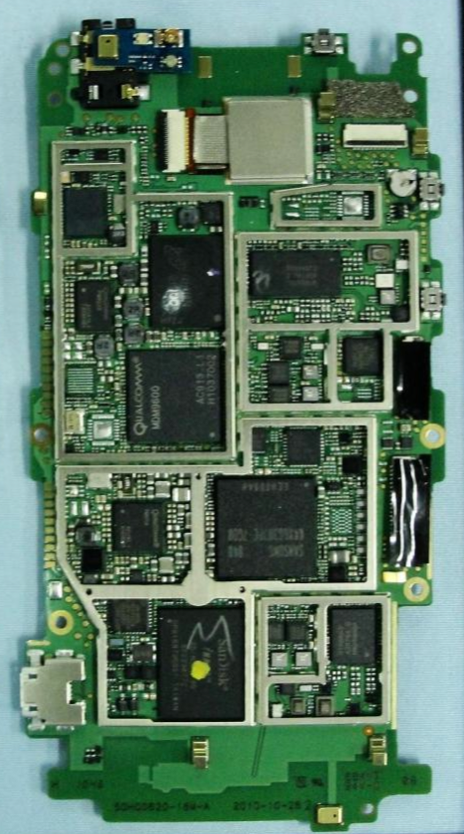
The Thunderbolt's one monolithic PCB - Source: FCC
Whether or not simultaneous voice and data is a deal-making feature is ultimately something philosophical. For me at least, I’ve found that having data sessions pause while I send or receive SMS messages is reason enough for preferring the Thunderbolt over any other CDMA2000 based smartphone to date. The other use scenario that’s compelling is if users want to use an LTE enabled smartphone for tethering.
Thanks to its unique relationship with Qualcomm, HTC will likely have the only simultaneous EVDO/LTE and 1x voice handset for some time. The LG Revolution for example includes MSM8655 and LG’s L2000 LTE-only chipset, the Samsung 4G LTE smartphone (the Droid Charge) uses Hummingbird and probably just an MDM9600 for voice and data, and the Droid Bionic (whatever its status) likely will have a similar single baseband architecture. Recent literature from Verizon suggests that the Droid Charge will be simultaneous voice and data, but only in LTE markets - I strongly suspect this will be how the majority of other first gen LTE phones behave. In addition, voice on the Thunderbolt is not affected at all when transacting data because it’s the same old 1x voice that Verizon always has used. It isn’t VoIP, it’s the same *real* voice connection it always was. I found that voice and data work perfectly at the same time on the Thunderbolt.
4G LTE Thunderbolt Performance Testing
So how does LTE throughput stack up on the Thunderbolt, especially compared to EVDO? A number of other testers noted that speedtest.net shows erroneous upstream speeds thanks to the Thunderbolt’s huge transmit buffer when on 4G LTE.
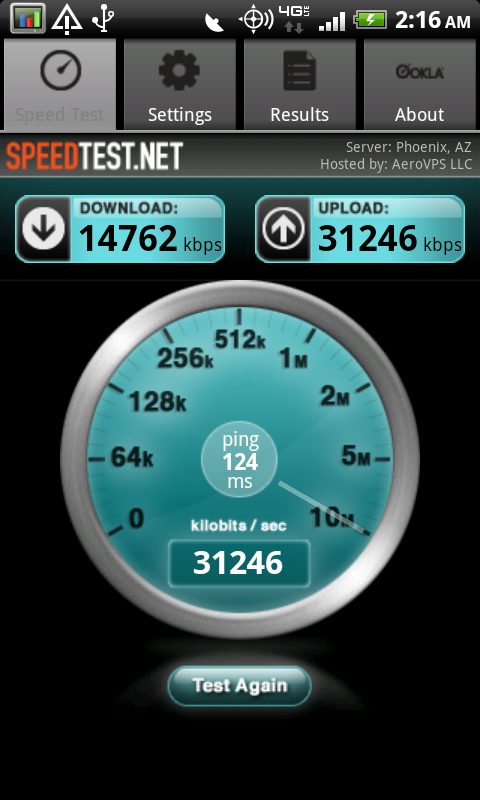
Sorry, there's no way it's uploading at 32.2 Mbps
What happens is that the speedtest.net app’s upstream test size is almost aligned in size with the transmit buffer, so not enough samples are taken to show the realistic speed. Run the test, watch it, and you get a very token bucket looking throughput pattern. What ends up being measured is nonsense for upstream, but nearly valid for downstream. The Android Speedtest.net app has since been updated and shows the proper upstream throughput profile and has a UI that matches the iOS version, but my testing was originally done when the old version was the only option.
All of that isn’t a huge deal however, since we can browse the real web version inside the flash enabled browser. Yay for mobile flash!
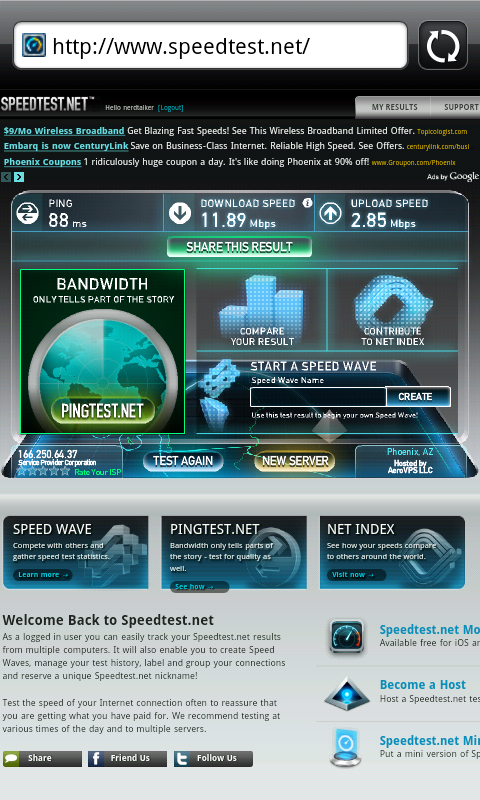
I’ve run a ton of tests on the Thunderbolt in just about every coverage scenario imaginable up in Phoenix, AZ. At interstate speeds on the I-10, 202 loop, downtown central Phoenix, inside every mall (yes, every major mall), indoors, outdoors, good and bad coverage, you name it. There’s even more testing in the LTE piece, but here I’m presenting results just from the Thunderbolt acquired from running the flash version of speedtest.net. All together this is 163 data points collected for the Thunderbolt alone.
First up is downstream. I've collected results for both 4G LTE and 3G EVDO:
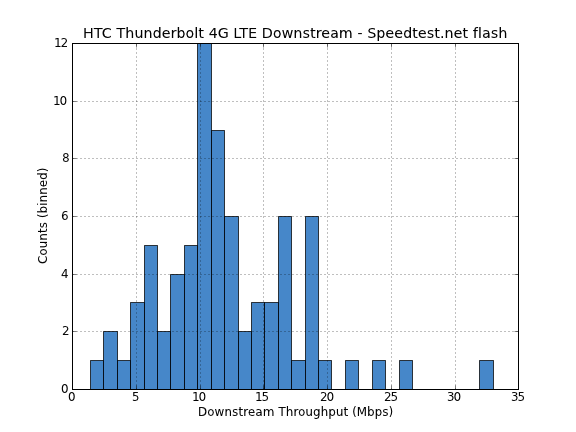
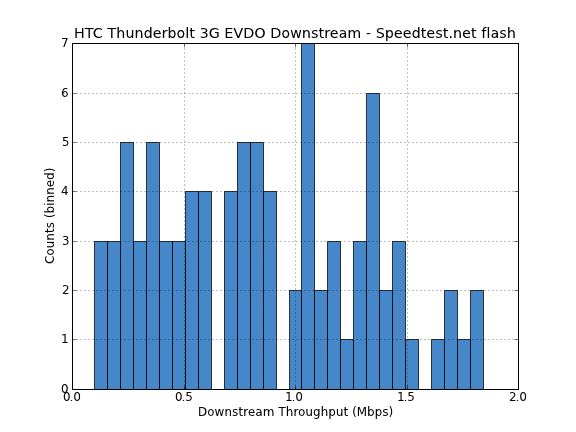
Next up is upstream, again on both 4G LTE and 3G EVDO:
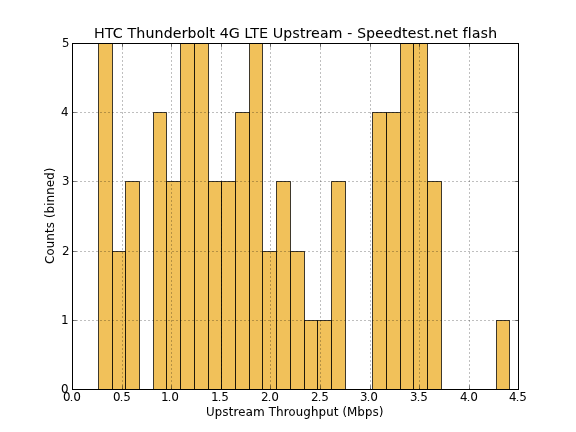
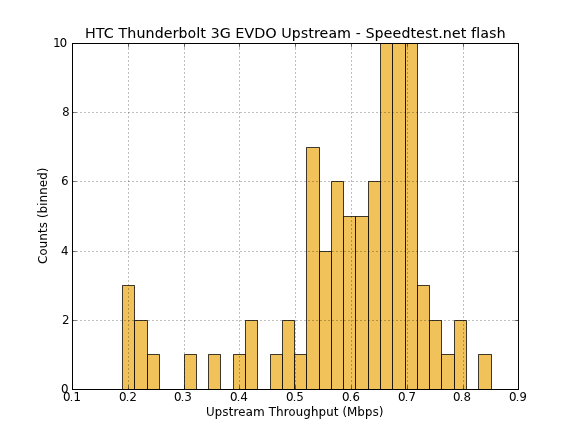
Finally we have latency, again on 4G LTE and 3G EVDO:
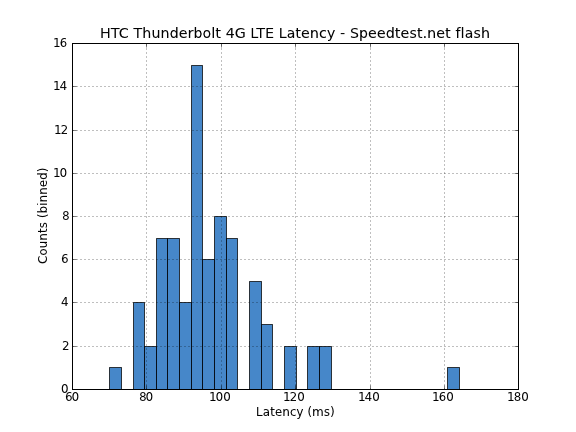
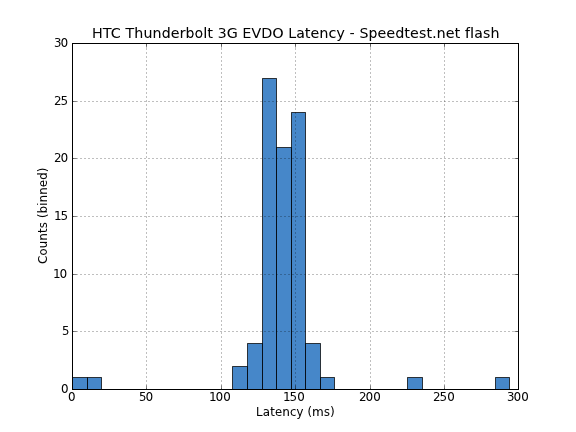
What’s interesting is that upstream speeds on the Thunderbolt are a bit more spread out than for data cards, likely due to the 1 Tx stream (as opposed to two for others). Downstream speeds are impressive, however, clustered primarily around 10 Mbps. Latency is also clustered around 90 ms.
What really speaks to me, however, is that with 4G LTE, worst case speeds are as slow as EVDO is fast. Put another way, LTE’s slowest is about EVDO’s fastest.
Average speeds are about an order of magnitude faster on LTE than EVDO. Latency is down from around 150 ms on EVDO to around 90 ms on LTE.
Coupled with the WiFi hotspot feature, it’s also finally feasible to play games over cellular when on 4G LTE without having insane amounts of latency. While you can arguably survive with some consoles on EVDO or HSPA right now thanks to copious amounts of latency interpolation, nothing really beats actually having sub 100 ms latency. I found that I was able to play CS:S to a nearby server hosted in the same locale and get 70-80 ms of latency tethered over WiFi on the Thunderbolt. By comparison, using a Pantech UML290 (4G LTE datacard) netted me between 50-60 ms. It’s clear that NAT and WiFi overhead add around 20 ms to the connection, but overall the result is a totally usable experience. I've put together a video showing this all in action.
4G LTE implementational details are also important, and I found that the Thunderbolt is close to perfect. The initial handover when you enter an LTE enabled market is a little long. I drove from outside the greater Phoenix metro area into coverage multiple times and timed about 3-5 minutes before hard handover happened. That’s of course if you don’t provoke the handover to happen manually by toggling airplane mode or through *#*#4636#*#* (4636 stands for info) as I’ll show in a minute. When you’re already inside LTE coverage area and simply drop down to 3G, handing back and forth is much faster, it’s nearly instantaneous.
I definitely noticed that Verizon’s 700 MHz spectrum (which is allocated to LTE) does have better propagation characteristics in urban environments that are traditionally very hard to get done right. Large malls and shopping centers specifically are notoriously bad, and the Thunderbolt had no issue clinging to 4G signal in all but the worst areas. In those edge cases, it’ll fall down to EVDO or 1x. I did find that sometimes the LTE to EVDO handover happens a bit more than I’d like it to, if you know you’re in an LTE coverage area, however, you can force LTE only through info.
One of the major complaints and curiosities about the Thunderbolt is that there’s no toggle for 4G LTE in the higher level user menus. If you’re in an LTE market, it makes sense to use it whenever possible, however there are measurable power savings from using EVDO only. In either scenario however the two cellular modems are both powered on. With the Thunderbolt I’m more concerned with keeping LTE always selected and never handing over to anything less. Allow me to introduce you to Phone Information.
There’s an app floating around that gets you here, or you could make a shortcut using anycut, but it’s always been accessible using a dialer code. I simply dial *#*#4636#*#* whenever I want to get here.
Virtually every Android phone has this menu and the same options, unless the carrier has gone to lengths to disable it. The Samsung Fascinate, for example buried this under a ton of obfuscation, and the HTC Inspire 4G disallows selection of anything less than constant HSPA, but I digress.
Tap Phone Information, and now you get access to a lot of status information including signal strength in dBm and asu, some cell location info, network attach status, and the connection type. Here you can see CDMA - eHRPD in EVDO (enhanced High Rate Packet Data), CDMA - 1x or LTE when in appropriate coverage. Tap “set preferred network type” and you can now select between a number of options. LTE mode is unsurprisingly for an LTE-only mode, standard is CDMA + LTE/EVDO auto, EVDO and CDMA only are both self expanatory. Keep in mind that in every mode the MSM8655 modem is still on and maintaining a 1x voice or data connection. I find this menu again more useful for forcing LTE only and avoiding any annoying hard handovers if you’re absolutely certain you are in an LTE coverage area. You don’t need to use it though, everything works fine out of box.


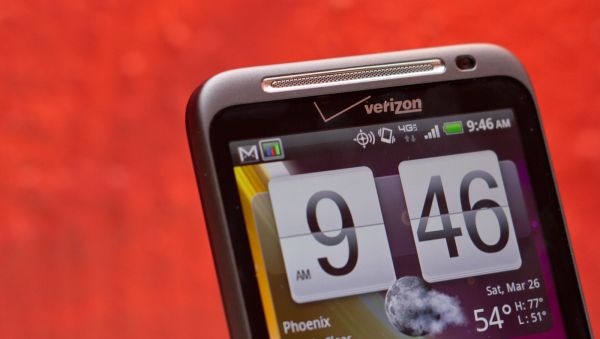
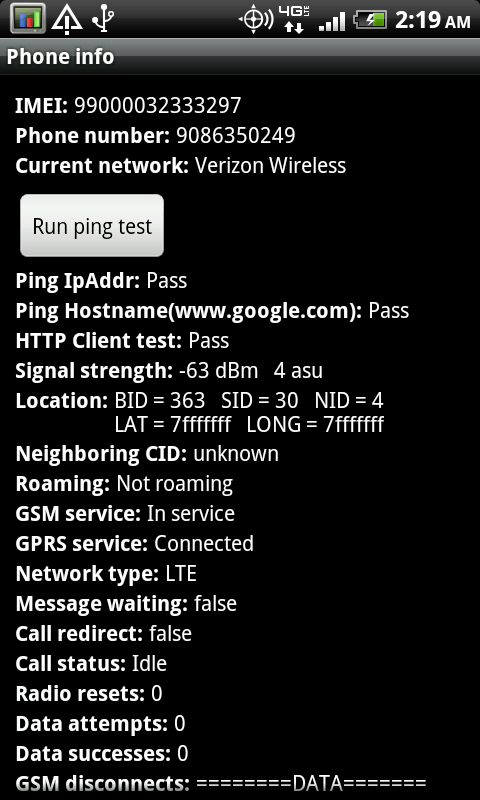
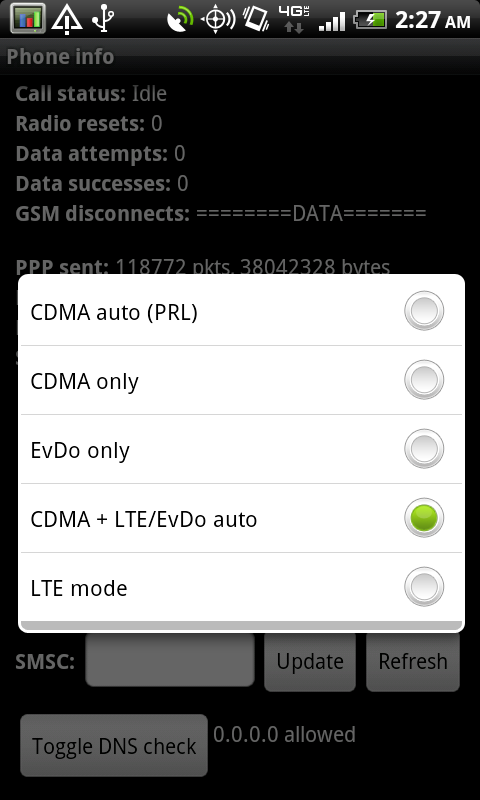








71 Comments
View All Comments
Brian Klug - Wednesday, April 27, 2011 - link
I've accidentally gone with graphs that lacked that data and updated them with the Thunderbolt results. Numbers from iOS 4.3 will be added shortly!Thanks for pointing that out!
-Brian
metafor - Wednesday, April 27, 2011 - link
There's a couple of things here. First is that Verizon's EVDO coverage is already pretty good. And instead of opting to go towards 1x Advanced, they've decided to go with a standardized LTE protocol instead to increase speeds; this is a good thing.Secondly, while HSPA networks can provide theoretical speeds compared to LTE, the real-world performance is far from the reality of that. OFDM is a far better modulation scheme compared to QAM when it comes to not just realistic peak bandwidth but also range and versatility that there really is no question that it should be the next generation of cellular.
name99 - Saturday, May 7, 2011 - link
"OFDM is a far better modulation scheme compared to QAM when it comes to not just realistic peak bandwidth but also range and versatility that there really is no question that it should be the next generation of cellular."OFDM and QAM are orthogonal issues.
OFDM is about how spectrum is allocated. Old school is to give each user one of a few dedicated fairly wide frequency bands while they are in a cell. This frequency may or may not work well for them and be appropriate to their needs.
OFDM splits the entire spectral range into lots of small frequency bands, and dynamically decides which user gets to use which of these bands, based on issues like both the user needs and how good transmission/reception to that user is at that particular time. In addition, it's easier for the receiver for apply a different equalization to each of these small frequency bands to undo the effects of echos on the received signal.
QAM is about the shape of the pulse that carries the information within each frequency band. The very specific details of this change from one spec to another, but to first order this is the same as its always been --- the same idea that was in use in 1980s modem, and I assume even earlier in things like microwave and satellite transmission.
As for ltcommanderdata's point, it is a mistake to assume that 4G is about higher peak speeds. Rather it is about
(a) a more consistent experience, so that data rates are less likely to fall off a cliff in bad conditions, like at the edge of a cell
(b) it is about better OVERALL use of the limited spectrum available. Under some conditions this will allow a few users to see very high speeds, but the more likely scenario in urban conditions is that it will allow more users in a cell to get acceptable speeds.
In other words, it's a way to achieve the goal you want --- better data coverage for more people --- but using technology that ultimately does a better job. Better in terms of spectral usage, and better in terms of more data throughput/dollar spent by the carrier.
alent1234 - Wednesday, April 27, 2011 - link
lucky for you verizon's LTE is 3G and not 4G. I think it's something like 3.9G. there is a new 3GPP spec almost every year. HSPA+ is 3.6 or 3.7G.real 4G is still a few years away
cmdrdredd - Thursday, April 28, 2011 - link
so? What's the problem? You get massive speed boosts anyhow which is what the consumer cares about. Nitpicking the little details of the network means jack.Omid.M - Wednesday, April 27, 2011 - link
Brian,How much of the battery drain would you say is due to the first gen LTE antenna? I mean, I assume at this point we can call it first gen, right?
The Thunderbolt is in an odd spot in the VZW lineup. I feel it was rushed to showcase LTE---which it has done a great job of---but the phone itself isn't impressive in any specific way. It's not necessarily faster than other phones, the screen tech isn't amazing, and it's just really thick.
I agree with you on the qHD point: why can't manufacturers put out qHD with non-pentile matrix? Manufacturing-wise, is there a hold up? Is it an issue of contracts with vendors that need to end? I don't get it.
I keep seeing these smart phones that really just fall short in a way you think they could easily deliver.
Oh, and I didn't see you mention HTC's infamous "bump charging." I hear it's an issue with the Thunderbolt, too. Thanks for the awesome review. Super in depth!
@moids
Brian Klug - Wednesday, April 27, 2011 - link
@moids,It's hard to say for certain really how much of that battery life hit is the second cellular modem. I originally intended to measure current on both of the MDM9600 modems with an in-line ammeter, but didn't get a chance last time I was in a 4G market. That'll come in the next couple of weeks though. Obviously having two modems is going to affect battery life. The thing gets warm, which to me always is a good indicator that it's using lots of power.
I don't believe there's any reason why we can't have a qHD screen without Pentile. Keep in mind though that Pentile lets you emulate a higher resolution without needing to have 3 subpixels per pixel.
I've definitely seen the bump charging situation show up on the Thunderbolt. The first couple initial charges definitely showed that bump charge behavior, later on it got better, but Smart Panel showed a similar trend to that infamous XDA devs thread. I haven't really messed around enough to speak too intelligently about that issue than to say that yes, it does seem to still be kicking around. Maybe the Pyramid/Sensation will change things. I hope!
-Brian
yibrushn - Wednesday, April 27, 2011 - link
I am in a wimax market and they mean 3G data in that quote. 4G and calls are definitely a goBrian Klug - Wednesday, April 27, 2011 - link
Interesting! I pinged Qualcomm and was going to wait for them, but updated the article already. Thanks for pointing that out!-Brian
Omid.M - Wednesday, April 27, 2011 - link
Got it!By the way, if you guys implement a perm link feature that's per comment, I can reference certain..."issues"...for vendors to check out ;)
I want the Bolt because 4G in the Bay Area is STUPID FAST but it just feels like a sidegrade from my Fascinate. I'm pulling 10-12 hours with HEAVY use, 14-17 with moderate use, and well over 24 hours if I barely use it (hah). But, it took me many tweaks and still room for more tweaks.
I'm almost making pre-loaded Gingerbread a requirement of my next phone; I don't trust carriers/vendors anymore with promises of timetables. Yes, it has come to that: the OS version should be considered a marquee "feature." Sad.
The day that vendors stop caring about being first to market and care more about putting out a POLISHED experience is when we'll start to see others follow suit. There's no reason to rush products other than to meet a deadline by the higher ups.
I think it's fair to say that the negative impact of an unpolished product is far more damaging to credibility than the positive impact of being first to market (novelty).
Hear me, Verizon & HTC?